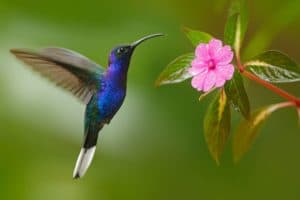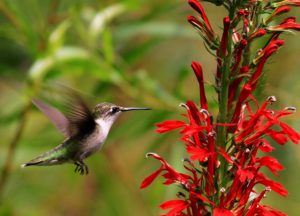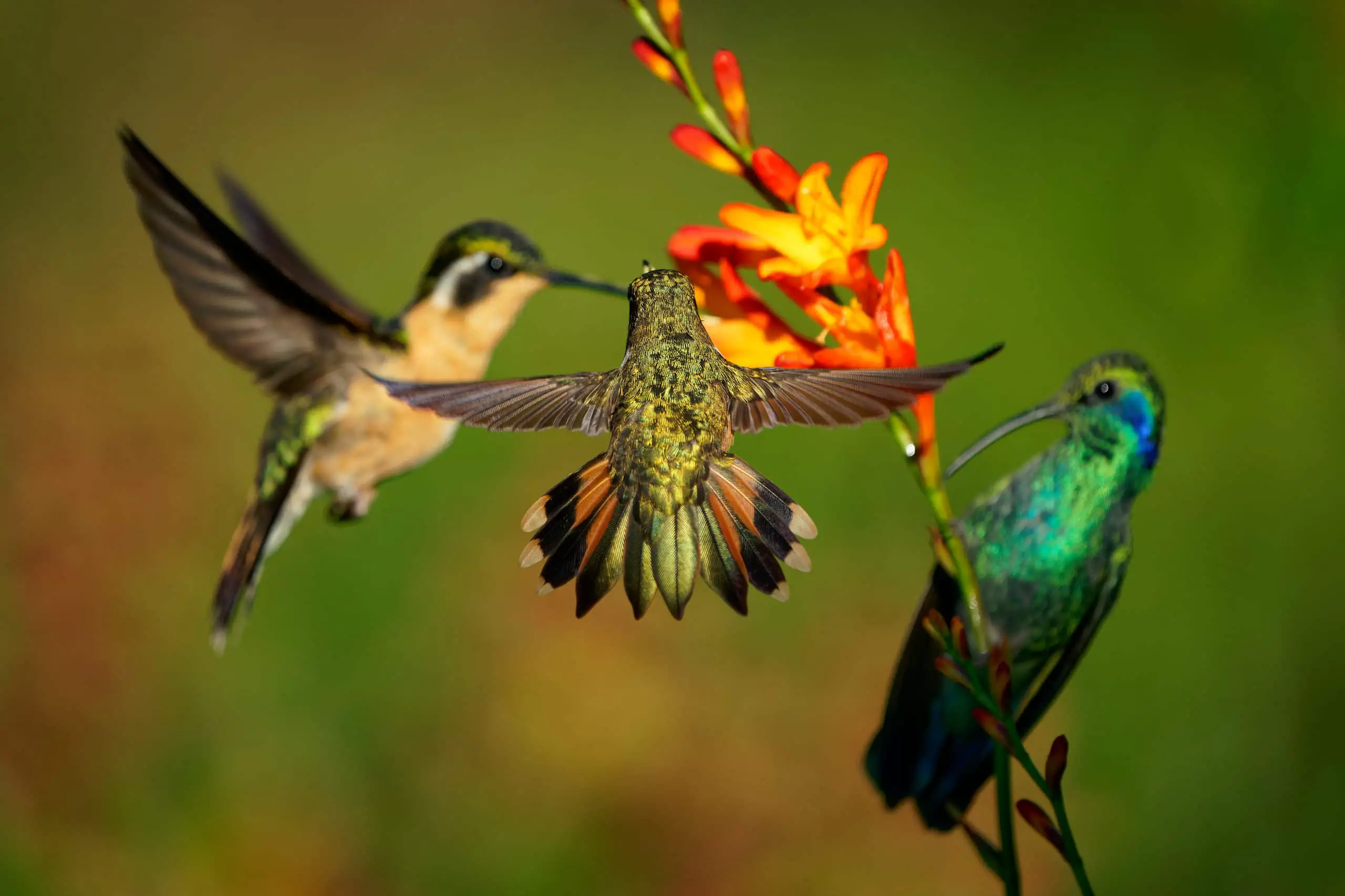There is only one thing that can surpass the magic of seeing a hummingbird suspended in midair – the sight of it dipping its long beak into a flower! If you love to watch this sight in your garden, you will need to know the flowers that attract Hummingbirds to your Garden.
You will often hear Hummingbirds before you see them. If you see two or more of them together, you will hear sharp noises as they aggressively dive and swoop in a series of aerial maneuvers.
Gardeners love to encourage Hummingbirds to do their acrobats because it is such a fantastic sight. There is no better way to do that than to plant flowers that attract Hummingbirds to your Garden and create an environment in your garden that is friendly to Hummingbirds.

Fun Facts about Hummingbirds
Before getting into the flowers that attract Hummingbirds, here are some facts about these interesting little birds.
• Hummingbirds fly in all directions, including backward. Their wings can beat up to an amazing 80 bps (beats per second).
• They have brightly colored and translucent feathers
• The quick and swift movements, thus they have been nicknamed as “flying jewels.”
• Hummingbirds spend a lot of energy while whooshing around the Garden, thus they have to eat food equivalent to ½ of their body weight every day to replace their burned calories. This means frequent trips to a lot of flowers almost the entire day.
• Hummingbirds can fly in midair while sipping nectar with their slender and long beaks from brightly colored flowers.
To attract Hummingbirds to your Garden, you need to create a perfect garden environment for them.
Tips in Choosing Flowers that Attract Hummingbirds
Many people have been amazed by the beauty and aerobic capabilities of Hummingbirds. The key to attracting hummingbirds to your garden is to select flowers that attract Hummingbirds.
• Hummingbirds need a lot of space between plants to give them enough room to navigate and hover from one flower to another.
• Flowers, flowering shrubs, vines, dwarf trees, and herbs from the ground and up to 10 feet tall are ideal habitats for hummingbirds.
• Hummingbirds love tubular and brightly-colored flowers because they have the most nectar. They are also observed to be frequently visiting yellow, orange, blue, and even purple flowers.
• Hummingbirds love red flowers – which are their favorites; however, they also feed on flowers with different colors. Hummingbirds arriving in western interior mountain gardens in late April feed on flowers with varying colors because only a few red flowers are in bloom during this time.
• Hummingbirds go for flowers that have tapered or long shapes because these flowers can accommodate their long bills. These flowers also have a lot of nectar so they can keep on coming back for repeated sips.
• Not all flowers have the same intensity of attracting Hummingbirds. Some flowers are more enticing to them, while others are not.
• Hummingbirds prefer native flowers because they are more familiar with them.
• Pick plants that have repeated blooming or long bloom times. They will be able to provide hummingbirds with a reliable source of food.
• It is best to plant multiple species of hummingbird flowers in your garden. A diverse garden will be attractive to Hummingbirds and provide different hummingbird species with ample food through spring, summer, and fall. You can also pick flowers that blossom through mild winters if you live in the southern areas.
Hummingbirds always rely on bright colors such as the color red when finding food because they do not have a sharp sense of smell. They also love moving water. A perfect bath could be a continuous and gentle spray from a sprinkler hose
All About Nectar
Nectar is a sweet liquid produced by flowers and some plants. Nectars are not only lovely; they also contain vitamins, amino acids, vitamins, etc.
Plants produce nectar in their nectary glands. Depending on the species, floral nectars are located in different parts of the flower.
Pollination (the process of transferring pollen from one flower to another) allows flowers to produce nectar. Flowers need pollen to reproduce, but since plants are not mobile (do not move), they need help to transfer pollen.
A pollinator, such as a Hummingbird is an animal that helps transfer pollen from one plant to another. Nectar is the reward pollinators get because it helped the plant to transfer its pollen.
Each flower species comes with its unique phenology (when life cycles start and end). Each flower species produces different amounts of nectar. The amount of nectar produced by a flower also depends on its age, the precipitation amount, and the length of the season.
Production of nectars depends on these factors:
• The larger the flower, the more nectar it can produce.
• The availability of a flower’s nectar depends on the length of time it opens. A flower that is open the whole day will have nectars available the whole day. Flowers that open in the morning and close in the after will not have nectar available for the whole day.
• The older the flower the higher the concentration of nectar it can produce. Older flowers can also produce more nectar than younger ones of the same species.
• The sugar value of and concentration of nectar increases along with the increase in temperatures.
Hummingbirds as pollinators have a huge role in pollination. When a Hummingbird dips its bill down into a flower, pollen clings or attaches to its feathers and bills.
When hummingbirds visit other flowers, they transfer pollen from flower to flower. Pollens fertilize flowers which in turn produce seeds for survival.
Flowers that Attract Hummingbirds but not Bees
Flowers that pollinate with the help of Hummingbirds tend to confuse bees. Flowers Hummingbirds are attracted to, come with certain traits that discourage bees from visiting them.
Bees cannot see the color red too well, so they prefer upright flowers in purple and blue. Hummingbirds, on the other hand, choose orange or red horizontal flowers.
Flowers bees are attracted to have concentrated and small amounts of nectar. Hummingbirds love flowers that have diluted and large amounts of nectar.
When bees ignore flowers that are challenging for them, other pollinators, including Hummingbirds take over, and they feed on flowers that bees do not bother with.
Hummingbirds do not have a good sense of smell, and flowers use their scent to attract pollinators. Thus, hummingbirds are often attracted to unscented flowers.
If you need some suggestions of flowers that attract hummingbirds to your garden, here are some of the ideal flower species.
1. Cardinal Flower

Cardinal flowers are perennials. They have long tubular flowers that may be difficult for other pollinators to navigate but are perfect for the long bills of hummingbirds.
Hummingbirds are attracted to the sweet nectar and bright red color of the Cardinal flowers.
Cardinal flowers are best grown in areas that have the morning sun and the after shade. The soil should be rich, and the plant should be watered regularly to maintain the moistness of the soil.
2. Petunia
Petunias are the favorite of Hummingbirds because of their trumpet-shaped and large blooms. Petunias come in almost every color. They are also available in striped and spotted varieties and in single or double-flowered forms. They grow to be 10 to 10 inches wide and 6 to 10 inches tall.
The Petunia exserta comes with star-shaped red flowers and grows erect. It is the only Petunia species that only hummingbirds (no other flowers) can pollinate.
3. Trumpet Vine
Trumpet vines have tubular flowers growing on their perennial vine. They bloom in the colors of red, orange, and yellow, and bean-like seed pods are produced after the trumpet vine flowers.
Hummingbirds are attracted to Trumpet vines because of their color, high nectar content, and the trumpet-like shape of the flowers that can accommodate their long tongues, which operate like pumping mechanisms.
4. Calibrachoa
A Calibrachoa has the vibrant color of petunia but requires less maintenance. Calibrachoas are available in every color and come in single-flower form and double flower form. They can grow to be 30 inches wide and up to 10 inches tall.
Hummingbirds are attracted to Calibrachoas because of their trumpet-shaped flowers.
5. Columbine
Columbine or Granny’s Bonnet is a perennial that is easy to grow. They offer a colorful aesthetic to your garden almost the whole year. They produce bell-shaped blooms in many colors in the spring, and its dark green foliage becomes maroon in the fall.
Hummingbirds love Columbine flowers because their tubular flowers hold a large amount of nectar. They also come with bright-colored flowers.
6. Daylily
A Daylily comes with trumpet-shaped blooms. Each Daylily flower lasts for only one day but they grow in large numbers over many months. Daylilies bloom through summer and can thrive on a partial shade or full sun. They can grow to as wide as 1-1/2 inch to 4 feet and as tall as 4 feet.
Hummingbirds love Daylilies because they are attracted to their tubular hold and bright colors when searching for food.
7. Hollyhock
Hollyhocks bloom during the summer. They come with cup-shaped flowers. Depending on the cultivar, their blooms come in singles and doubles. Hollyhock flowers in the colors pink, lavender, red, purple, salmon, white, apricot, and yellow. Hollyhock blooms in mid-to-late summer. They thrive on full sun.
Hummingbirds love to visit Hollyhocks because of their deep red color.
8. Impatiens
Impatiens or Busy Lizzie is a flowering annual that creates colorful window boxes and flower beds. They can also be planted in containers. Impatiens require partial to full shade and moisture to grow. They bloom in the late spring through the first frost.
Hummingbirds cannot help but notice Impatiens because they come in rainbow hues. If you want to attract more hummingbirds to your garden, choose the brighter-colored Impatiens.
9. Begonias
Begonias usually grow to be not more than 12 inches tall. These plants love the shade and grow well in hanging baskets. You can place the hanging baskets near a window where you can enjoy seeing hummingbirds visit your Begonias to sip their nectar.
Hummingbirds are attracted to Begonias because they are colorful spring bloomers that come in rich colors.
Begonias can brighten up a shaded garden, and with minimal care, they can grow even in the least sunny spots of your garden. Begonias grow to be 5 – 6 inches wide and are often less than a foot tall.
10. Salvia
Salvia blooms for many weeks from early summer to mid-summer. Salvia comes in shades of deep pink, purple, and blue.
Hummingbirds are attracted to Salvia, particularly red Salvia which they can clearly see. Hummingbirds also love the sweet taste of the nectar of Salvias.
Final Thoughts
It can be so much fun to watch Hummingbirds hover around your garden and feed on your colorful and bright flowers.
Choosing flowers that attract hummingbirds to your garden is a natural way to produce valuable nectar during the blooming months.
Jenny Marie
Tribal Writer
Edited by
Patricia Godwin

